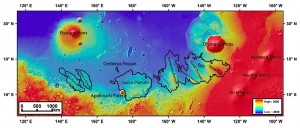Stretching more than 5,000 kilometers (3,000 miles) between the two volcanic centers of Tharsis and Elysium is a geological enigma, the Medusae Fossae formation. The formation, which lies in several separate patches, appears to be made of easily eroded materials, but its origins remain unknown.

LOCATION, LOCATION, LOCATION. While Apollinaris Patera is a relatively small volcano, it's placed just right to be the source for the Medusae Fossae formation (outlined in black). This enigmatic deposit appears to be made of easily eroded material, such as the fine ash produced in explosive eruptions. (Image is Figure 1 from the paper.)
A recent study led by Laura Kerber (Brown University) and published in Icarus examines the question of whether the formation was created by explosive eruptions from Apollinaris Patera, a volcano that lies next to one part of the formation. Such eruptions are called pyroclastic and produce large volumes of ash and other fine particles that can easily be carried on the wind.
A volcanic origin for the Medusae Fossae formation has been proposed for almost 30 years, but geologists have looked to bigger volcanos than Apollinaris for a source. Apollinaris is 5 to 6 kilometers high and nearly 200 km across its base. That’s big, but nothing like the giants found in Tharsis and Elysium. However, scientists think that Apollinaris’ eruption style favored explosive events that produced windblown ash rather than large volumes of runny lava, as produced in Tharsis and elsewhere.
“The height of Apollinaris and its position in the center of the deposit would make it possible for the volcano to disperse voluminous amounts of ash over the widespread areas covered by the Medusae Fossae formation,” notes the team.
They add that it’s likely the volcanic activity depositing the formation came not in a single episode, but in “many short eruptions (days to months) taking place over random times of the year over hundreds of millions of years.”
A recent rethinking of the age of the formation also favors Apollinaris as a source. Initially, the formation was believed to be younger than the last activity from Apollinaris, and therefore the volcano couldn’t have been the formation’s source. But because the soft materials in the formation erode easily, it presents a deceptively young appearance and more careful dating places it and the volcano as contemporaries.
Finally, while containing many uncertainties, computer models of the Martian climate support the idea that once lifted to altitudes of 15 to 20 kilometers in the atmosphere, pyroclastic debris from Apollinaris Patera could be carried by the wind for the distances required.
The team notes, “Depending on what time of the year a particular eruption took place, ash from Apollinaris could accumulate in different parts of the deposit.”








